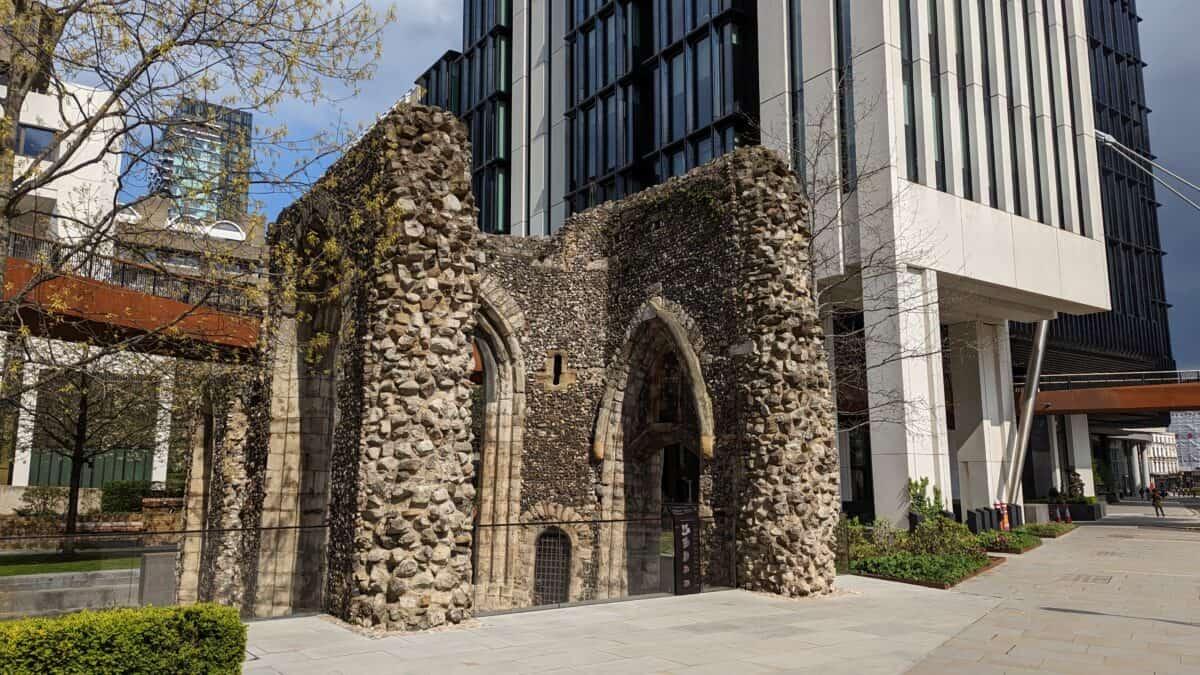In the Middle Ages, which was roughly between the years 1066 to 1500, the City of London was the largest town in England. It was a bustling centre of trade with its own independent government led by an elected mayor. Medieval Londoners built wharves and warehouses, replacing the Roman wall along the Thames, reclaiming land from the river and shaping the shoreline into something we know today.
Embed from Getty ImagesWe’re finding out about medieval doorstep deliveries and places of trade, as well as finding out why in 1536 the country’s religion abruptly changed and the deaths and destruction this caused.
There’s not much that remains today of the medieval City as the Great Fire of 1666 destroyed three quarters of the buildings within the city. Those that survived were built of stone, like churches and the Tower of London but if you know where to look, there are many hidden secrets from those times.
Embed from Getty ImagesCheapside
Cheapside is the road that runs from St Pauls to the Bank of England.
Embed from Getty ImagesIt’s been a bustling trading area for food and drink for many centuries. It’s believed to be London’s oldest street and in a way, the original ‘high street’. Its name comes from the Anglo-Saxon word ‘ceap’ meaning to buy or barter.
Side streets acquired names that indicated their early specialisations: fishmongers traded on Friday Street, while Honey Lane, Milk Street and Wood Street are self-explanatory.
Cheapside originally was more like a marketplace than a street. It was 62 feet wide but with very narrow exits at each end. After it was destroyed in the Great Fire, it was rebuilt without those bottlenecks, forming a continuous link with Poultry to the east.
Embed from Getty ImagesCheapside was famous in medieval times as the processional route for the monarch – The Royal Family and members of court would travel in fine carriages towards St Paul’s Cathedral and there would be feasting and celebrating in the streets – just imagine the scene…
Great Conduit
By 81 Cheapside is the Great Conduit.
There’s two things to look for! A blue plaque on the wall and a flagstone on the ground that marks the location of the conduit.

But first… what’s a conduit? On a hot day, what could be nicer than a glass of water? But in medieval times, where do you get one from… after all, the rivers would have been very smelly!
The Great Conduit was a man-made underground channel which brought a steady, free flowing supply of water from the Tyburn by Marble Arch to Cheapside where a building housed a great trough.

People could come and draw water in small amounts. Wardens stopped people taking too much and to repair pipes. The Conduit went out of use after the Great Fire. Whilst the water was freely available, there was a guild of watercarriers who took water from the conduit to households for a charge.
The Guildhall
The Guildhall is the home of the City of London Corporation and the centre of City government since the Middle Ages.

Originally, it was a place where rules and regulations were made by London’s merchants, and which helped make the city such a prosperous place. It’s not known exactly when the original Guildhall was built, but by around 1440 the Guildhall had undergone a makeover that transformed it from what was a little cottage into a great house, a building in the Gothic style, with oak for its frame, and lime, freestone and ragstone for the walls. It’s worth taking time in Guildhall Yard to get a full view.

When you are here, look at the white paving in the yard. They mark where the medieval yard would have been, when this was an enclosed space entered through a gateway.
On the left, the churchyard of St Lawrence Jewry extended as far as the Guildhall and on the right were the buildings of the chapel, Blackwell Hall market house where woollen cloth was stored and sold, and a public library, the first in England no less!
Embed from Getty ImagesThe façade of the Guildhall we see today was created in the 18th century by George Dance, in what’s known as the ‘Hindoo-Gothic’ style. The original medieval façade contained four statues which displayed the civic virtues of Temperance, Fortitude, Justice and Discipline. They can be seen in the Museum of London.
There are still medieval walls behind the façade in the Great Hall, including an original 15th century window with its horn panes and medieval iron work.
Saint Mary Aldermanbury Garden
Saint Mary Alderdermanbury Garden with its bust and memorial to William Shakespeare.

It’s less a memorial to Shakespeare and more a memorial to his fellow actors, Henry Condell and John Hemmings, who were buried in the churchyard of St Mary Aldermanbury nearby. You might not recognise their names of Condell and Hemmings, but they helped to put together the First Folio (or collection) of Shakespeare’s works in 1623.

Shakespeare’s London was a busy, bustling place, but also dirty and dangerous. The streets were narrow and dark, there were no police and it was often safer to travel by boat than on foot, that’s if they had money to do so.
Human waste was just thrown on the streets, and diseases from across the globe would sweep through London.
Imagine walking along those dark, narrow, stinking streets and seeing the rotting heads of criminals impaled on spikes.
St Alphage Garden and The Hospital of Elsyng Spittal
An urban garden that was converted from the former churchyard of St Alphage London Wall in 1872. The north edge of the garden is defined by a section of the city wall first built in Roman times.
Embed from Getty ImagesThe medieval hospital of Elsynd Spittal is named after city merchant Willliam Elsyng. He founded the hospital in 1330 to provide shelter, spiritual and physical care for London’s homeless blind.
It was possibly more like an alms-house than a hospital, providing a home for those who couldn’t look after themselves. It didn’t stay as a hospital for ever, it later became part of an Augustinian priory, a religious order known for their black hoods.
When monasteries were dissolved by Henry VIII in 1536, the buildings became the private house of the Master of the King’s Jewels, and later the church was taken over by the parish of St Alphage.
The derelict tower is the only remains of the medieval hospital. Looking at it from the road, to your right is the entrance to the church and the choir, to your left the entrance into the long hall of the hospital.

Behind you would have stretched the cloisters, cemetery and other hospital buildings.
St Giles Cripplegate
St Giles Cripplegate is a late medieval church. Lying outside the city walls, it would have served a semi-rural parish at that time, very different to the noise and activity at the Barbican today.
Embed from Getty ImagesThere’s been a church here since the 11th century, and if you’re wondering about the name, St Giles was the patron saint of those with disabilities and the infirm.
It’s had a turbulent time. Whilst it escaped the Great Fire, it was bombed in World War 2. Repairs were made using the original medieval plans and so you can see lots of detail from that time.
Embed from Getty ImagesCharterhouse Square
Charterhouse Square has been a lot of things over the years. A monastery, a private mansion, a boy’s school and an almshouse. It also has a more gruesome history.
Where today is a peaceful little park, was once a plague pit!

It’s called Charterhouse after the monastery built here in 1371. Every Monastery has an order, and this was founded by the order of ‘La Grande Chartreuse’. The building is very typical Tudor.

In 1371 this was the last religious house to be founded in London before Henry VIII’s dissolution of the monasteries.
There’s a museum inside and also a chapel to explore.
Look for the names the schoolboys carved into the pews.
Whilst Charterhouse is a Tudor building, when we think of Tudor buildings we probably think of something a bit different like Wattle and Daub and exposed timbers.

St Bart’s Gatehouse
A church and priory were originally built here in the 12th century, and were much bigger than the church here today.

The priory was another dissolved by Henry VIII’s and the nave was destroyed. In 1595, a local resident grabbed the opportunity to build a house on top of the remains of the nave’s southern doorway.
It wasn’t the fanciest house in medieval London but its location was second to none and miraculously survived the Great Fire because of the huge walls of the old priory.

In the 18th century a Georgian facade was built over the Tudor timber and the original front was lost from sight. It’s interesting past was only revealed after a bomb from a German Zeppelin raid in 1917 damaged the Georgian front and the original Tudor frontage was revealed and subsequently restored.
St Bartholomew’s Hospital
St Bartholomew’s Hospital is London’s oldest medical foundation and has given continuous care on the same site longer than any other hospital in England.
Embed from Getty ImagesIt was founded in 1123 by a man called Rahere. He was a courtier to Henry I. It is said he got ill on his way to Rome and had a feverish dream in which St Bartholomew came to him and told him to build a church and a place to treat the sick in his name. So he did!
Embed from Getty ImagesAs we know, Henry VIII wasn’t very happy with the Catholic Church and had many churches destroyed, including the one here. With no church for financial support, the future for the hospital looked bleak. Many Londoners took pen to hand and petitioned the King, who relented and gave the hospital to the City of London and so the hospital survived.
It’s still going strong!

If you look above the gate, you’ll see a statue of Henry VIII.
In the early 1700s, this gate was rebuilt and in honour of Henry giving the hospital to the city, they erected a statue. He would have loved it, just a shame it was nearly 200 years after he died.
Embed from Getty Images Add a commentLondon’s History
London has a rich and full history that we can't wait to tell you all about! From The Romans of Londinium to the Tudors of London, it's all here.
More From London’s History






